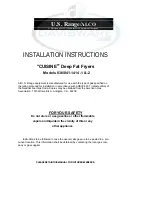
In the event of a fault or for clean-
ing purposes, the machine is only
completely isolated from the electricity
supply either when:
– it is switched off at the mains or
– the mains fuse is withdrawn.
Adequate ventilation is essential,
especially where another ap-
pliance which also uses the room air
(e.g. gas, oil or coal fired heater, con-
tinuous flow or other water heater), is in-
stalled in the same or an adjacent
room. To ensure safe operation, and to
prevent gases being given off by these
appliances being drawn back into the
room, an underpressure of 4 Pa is the
maximum permissible. Ventilation can
be maintained by air inlets which can-
not be blocked, in windows, doors and
outside wall vents, or by an automatic
window opening arrangement when the
tumble dryer is switched on.
If in any doubt, the advice of a compe-
tent builder, or for gas, a "Corgi" regis-
tered installer (in the UK) must be
sought.
Vented dryers must be installed
with a suitable venting system. If
the machine is not correctly ducted it
will draw damp exhaust air back into
the drum, increasing running time and
energy consumption quite consider-
ably. If moist air is passed back into
the room this may lead to long-term
damage of walls.
The exhaust air must not be
vented into a chimney or vent flue
which is in use. Neither should it be
connected to ducting which ventilates
rooms with fireplaces. It would be dan-
gerous if smoke or exhaust fumes were
drawn back into the room.
Always close the door after use.
This way you will avoid the danger
of:
– anyone sitting or leaning on the
door, which can cause the machine
to tip up.
– children climbing onto or into the
dryer or hiding things in it.
Do not install the machine in a
room where the temperature may
drop below freezing. At very cold tem-
peratures the machine may be difficult
to start. Laundry will not dry, and the se-
quence indicator light
~
r
Anti-
crease/End will flash to indicate a problem.
Warning and safety instructions
5






































